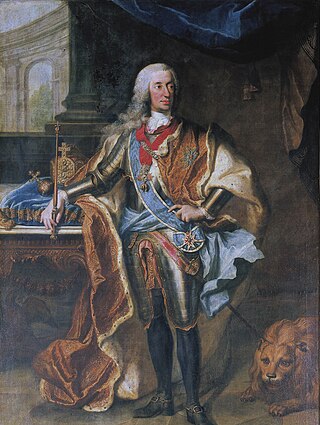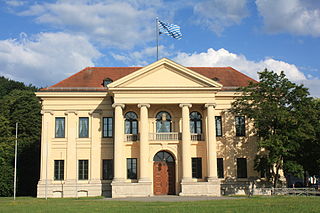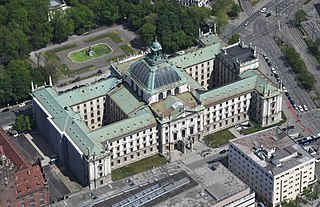
Charles VII was Prince-Elector of Bavaria from 26 February 1726 and Holy Roman Emperor from 24 January 1742 to his death. He was also King of Bohemia from 1741 to 1743. Charles was a member of the House of Wittelsbach, and his reign as Holy Roman Emperor thus marked the end of three centuries of uninterrupted Habsburg imperial rule, although he was related to the Habsburgs by both blood and marriage.

The Albertina is a museum in the Innere Stadt of Vienna, Austria. It houses one of the largest and most important print rooms in the world with approximately 65,000 drawings and approximately 1 million old master prints, as well as more modern graphic works, photographs and architectural drawings. Apart from the graphics collection the museum has acquired, on permanent loan two significant collections of Impressionist and early 20th-century art, some of which are on permanent display. The museum also houses temporary exhibitions. The museum had 360,073 visitors in 2020, down 64 percent from 2019 due to the COVID-19 pandemic, but still ranked 55th in the List of most-visited art museums in the world.

The Schleißheim Palace comprises three individual palaces in a grand Baroque park in the village of Oberschleißheim, a suburb of Munich, Bavaria, Germany. The palace was a summer residence of the Bavarian rulers of the House of Wittelsbach.

Palais Harrach is a Baroque-style palace located at Freyung 3 in Vienna, Austria. It was originally owned by the noble Harrach family. The building was extensively restored and renovated in the late 1990s, and it now houses offices and shops.

Palais Epstein is a Ringstraßenpalais in Vienna, Austria. It was built for the industrialist and banker Gustav Ritter von Epstein. The architect was Theophil Freiherr von Hansen, who also designed the adjacent Austrian Parliament Building. Unlike traditional Baroque noble palaces in Vienna, Palais Epstein was built in the late 19th century and is therefore considered a Ringstraßenpalais. It is up to five storeys high and built in the neo-renaissance style typical of its time.
The Herrengasse is a street in Vienna, located in the first district Innere Stadt.

Holnstein Palace is an historic building in Munich, Southern Germany, which has been the residence of the Archbishop of Munich and Freising since 1818.

Fürstenried Palace is a Baroque maison de plaisance and hunting lodge in Munich, Germany. It was built from 1715 to 1717 for Elector Maximilian II Emanuel. Today the palace serves as spiritual house for archdiocese and as pastoral center.

Schloss Porcia is a castle in Spittal an der Drau, in the Austrian state of Carinthia. It is one of the most significant Renaissance buildings in Austria.

The Brown House was the name given to the Munich mansion located between the Karolinenplatz and Königsplatz, known before as the Palais Barlow, which was purchased in 1930 for the Nazis. They converted the structure into the headquarters of the National Socialist German Workers' Party. Its name comes from early Nazi Party uniforms, which were brown. Many leading Nazis, including Adolf Hitler, maintained offices there throughout the party's existence. It was destroyed by Allied bombing raids during World War II.

The Palais Preysing is a late-Baroque mansion in Munich, southern Germany, which served as residence for the Counts of Preysing. To distinguish it from the nearby Palais Neuhaus-Preysing, it is also called the Elder Palais Preysing.

The Prinz Carl Palais in Munich is a mansion built in the style of early Neoclassicism in 1804–1806. It was also known as the Palais Salabert and the Palais Royal, after its former owners.

The neoclassical Brienner Straße in Munich is one of four royal avenues next to the Ludwigstraße, the Maximilianstraße and the Prinzregentenstraße. The boulevard was constructed from 1812 onwards, during the reigns of Maximilian I Joseph of Bavaria and his successor Ludwig I, in accordance with a plan by Karl von Fischer and Friedrich Ludwig von Sckell. The avenue is named after the Battle of Brienne.

The Justizpalast Munich are two courthouses and administrative buildings in Munich.

Max-Joseph-Platz is a large square in central Munich which was named after King Maximilian Joseph. Max-Joseph-Platz serves as the western starting point of the royal avenue Maximilianstraße.

St. Anne's Church in Augsburg, Germany, is a medieval church building that was originally part of a monastery built in 1321. It is notable for its elaborate interior decoration.

Salvatorkirche is a gothic church in Munich, Germany, the former cemetery church of the Frauenkirche. Since 1829 the church has been used by Greek Orthodox Christians and it was the headquarters of the Metropolitan of Germany and Exarch of Central Europe. It is called "Transfiguration of the Savior" by the Greek Orthodox community.

Palais Porcia is a former urban residence in the western quarter of the Innere Stadt of Vienna, Austria. It stands at 23, Herrengasse between Palais Kinsky and Palais Trautmansdorff and across Palais Harrach. The palace was built in 1546 for the descendants of Count Gabriel von Salamanca-Ortenburg. It was representative of the simple Renaissance style that emerged in Vienna in the middle of the 16th century. In the 17th and later centuries it was extensively remodelled in Baroque and Rococo styles but the inner court still contains an early Renaissance arcade. As of 2010, Palais Porcia houses the Administrative Library of the Austrian Federal Chancellery.

The Komödie im Bayerischen Hof is a large private theater in the Hotel Bayerischer Hof, Munich, Bavaria, Germany. Comedies, musical comedies, musicals and revues are performed in the 570-seat theater.

The Kardinal-Faulhaber-Straße is a street in the old town of Munich. It runs from Salvatorplatz in a southwesterly direction to Promenadeplatz.



















